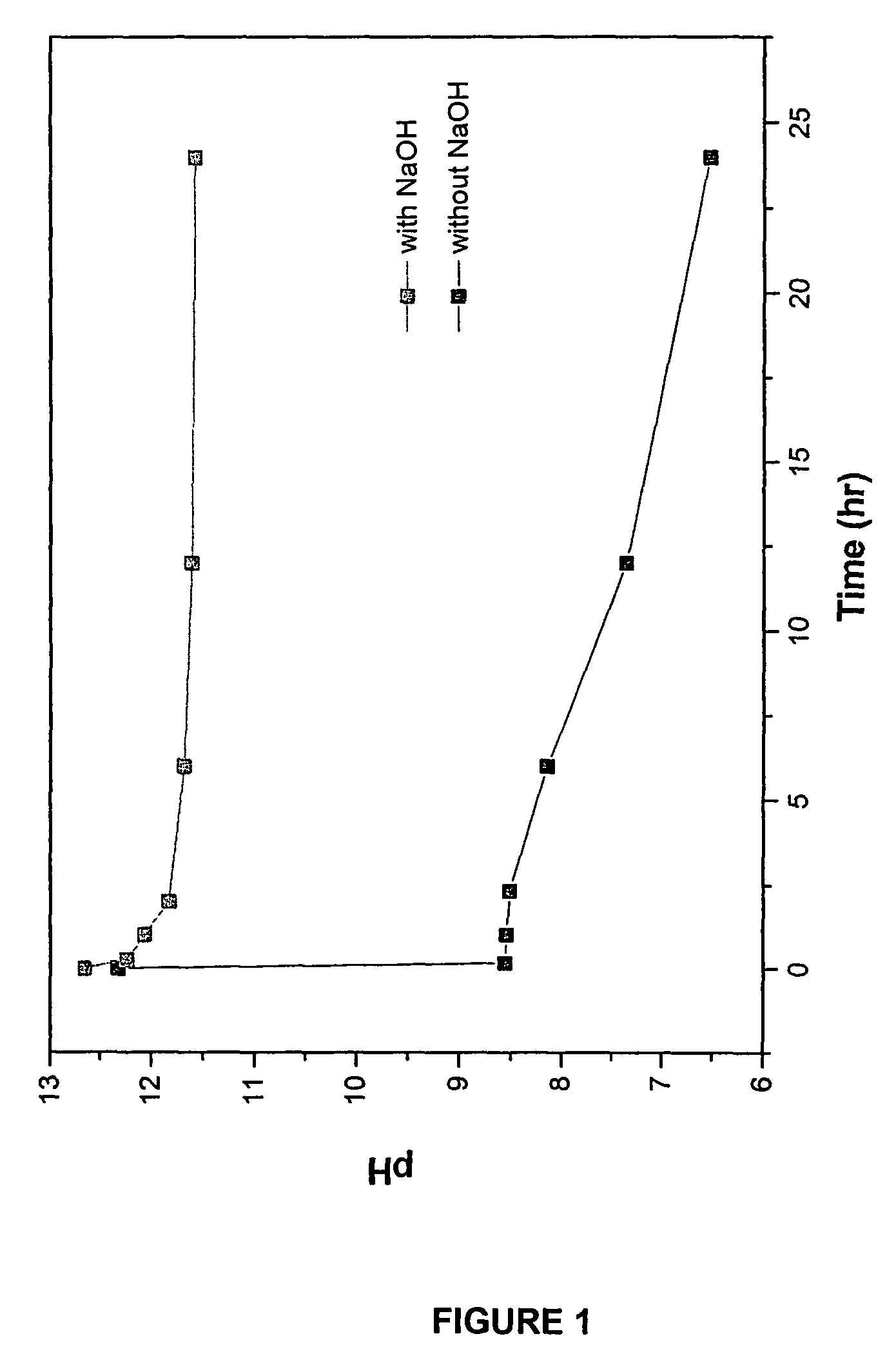Method of manufacturing hydroxyapatite and uses therefor in delivery of nucleic acids
a technology of hydroxyapatite and nucleic acid, which is applied in the field of preparing hydroxyapatite, can solve the problems of rapid aggregation of particles over time, coarse microstructure growth and coarsening of grains, and even more severe phenotype, and achieves high transfection efficiency and high efficiency
- Summary
- Abstract
- Description
- Claims
- Application Information
AI Technical Summary
Benefits of technology
Problems solved by technology
Method used
Image
Examples
example 1
[0088]Hydroxyapatite was chemically synthesized using CaCl2 and Na3PO4 in water. The overall chemical reaction in aqueous route can be described as follows:
10CaCl2+6Na3PO4+2NaOH→Ca10(PO4)6(OH)2+20NaCl
[0089]In the reaction, 1.3293 g Na3PO4 was added to 80 mL water and the Na3PO4 was dissolved by mixing for 30 minutes. To the Na3PO4 solution was added 0.1080 g NaOH, which was stirred for 30 additional minutes. To form nanocrystalline hydroxyapatite, 1.5 g of CaCl2 (100 mL of 0.135 M CaCl2) was added to the Na3PO4 / NaOH solution and the solution was mixed for 24 hours. After the reaction, the by-product NaCl was removed by periodic washing with water followed by centrifuging the solution. The resultant paste obtained was dried in air.
[0090]The hydroxyapatite powders obtained after drying were heated to 1000° C. in air to analyze its thermal stability. The chemical composition and stoichiometry of the synthesized hydroxyapatite was analyzed by investigating its thermal stability in the p...
example 2
Plasmid Gene Delivery Using Nanosized Calcium Phosphate Particles
[0108]As shown schematically in FIG. 7, one use for gene delivery is in tissue engineering or reconstruction. In these methods, a gene activated matrix (GAM) is provided in which DNA is incorporated into a structural matrix. When the GAM is inserted at a desired location in vivo, for example in bone tissue as a bone growth matrix, granulation tissue fibroblasts proliferate and migrate from viable tissue surrounding the bone wound. The cells then uptake and transiently express plasmid DNA and will act as local in vivo bioreactors, producing plasmid-encoded proteins that stimulate bone healing (Boniado (2000), J. Mol. Med. 78:303-311).
[0109]It is therefore desired to develop a non-viral gene delivery carrier, such as, without limitation, a GAM, that provides improved transfection efficiencies through the addition of a transfecting agent such as calcium phosphate (calcium phosphate).
[0110]The delivery system described her...
example 3
Treatment of Carious Lesions by Gene Therapy
[0120]It is believed that gene delivery of growth factor(s) into the injured site may limit the inflammatory response, accelerate tissue regeneration and lead to the deposition of mineralized dentin of physiological quality.
[0121]The pulp injury model described herein is a well-established model and has been used extensively by many investigators (Hu, C. C., et al., “Reparative dentin formation in rat molars after direct pulp capping with growth factors,”J. Endod., (1998) 24(11):744-51; Rutherford, B., “Dentin regeneration,”Adv. Dent. Res., (1995) 9(3 Suppl):14; Rutherford, R. B., et al., “The time-course of the induction of reparative dentine formation in monkeys by recombinant human osteogenic protein-1,”Arch. Oral Biol., (1994) 39(10):833-8; Imai, M., et al., “Ultrastructure of wound healing following direct pulp capping with calcium-beta-glycerophosphate (Ca-BGP),”J. Oral Pathol. Med., (1993) 22(9):411-7 and Heys, D. R.,
[0122]et al., “...
PUM
| Property | Measurement | Unit |
|---|---|---|
| size | aaaaa | aaaaa |
| pH | aaaaa | aaaaa |
| size | aaaaa | aaaaa |
Abstract
Description
Claims
Application Information
 Login to View More
Login to View More - R&D
- Intellectual Property
- Life Sciences
- Materials
- Tech Scout
- Unparalleled Data Quality
- Higher Quality Content
- 60% Fewer Hallucinations
Browse by: Latest US Patents, China's latest patents, Technical Efficacy Thesaurus, Application Domain, Technology Topic, Popular Technical Reports.
© 2025 PatSnap. All rights reserved.Legal|Privacy policy|Modern Slavery Act Transparency Statement|Sitemap|About US| Contact US: help@patsnap.com



